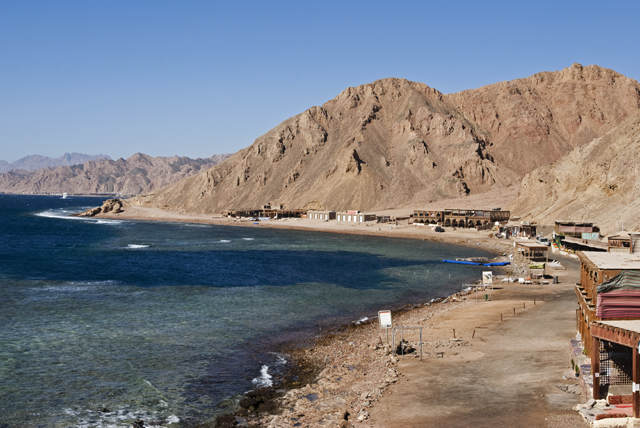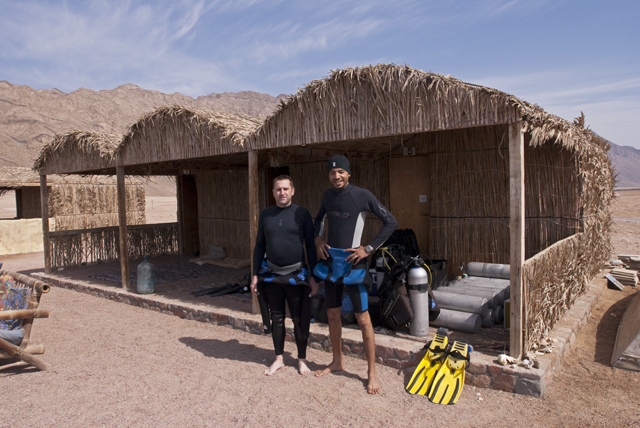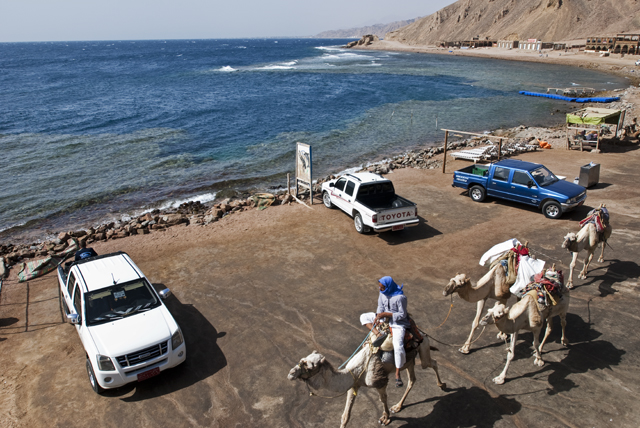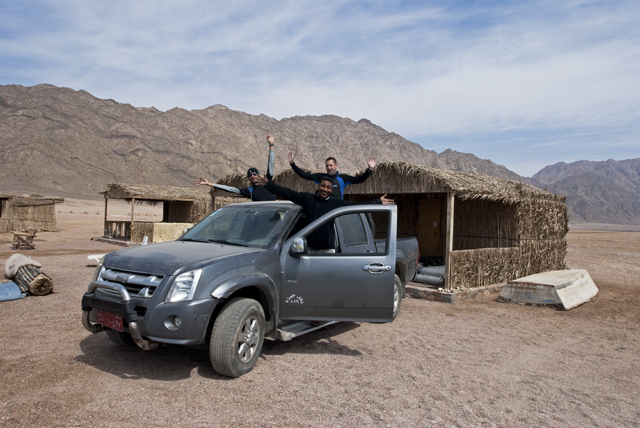News
Carry on Camel
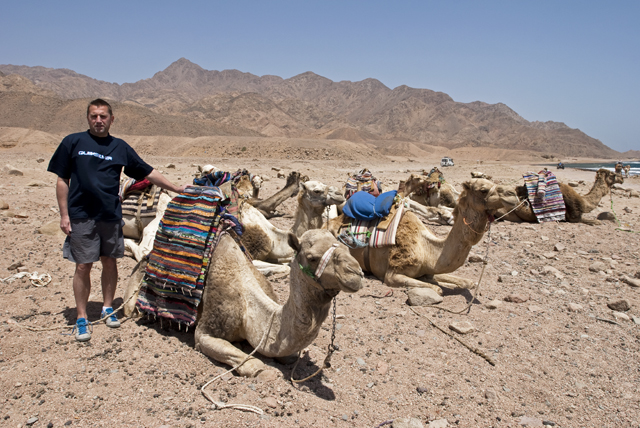
In my mind the combination of scuba diving and riding camels is like putting peanut butter and jelly in the same sandwich; they just don’t go together. I know that camels are called ships of the desert but that’s about the only ‘nautical’ similarity there is between the two! I’m not even sure that camels like getting wet, and when I suggested dunking a camel in the sea my Bedouin guide thought I was stark raving mad and started laughing at me.
My grand Egyptian plan was to get far away from the madding crowds and check out the sites rarely visited by other divers. Using a more traditional mode of transport seemed to fit in with my ‘getting back to basics’ theme, hence bring on the camels. Hayden Falloon, the owner of Black Rock Dive Centre in Dahab, suggested that I sign up for one of his special 2-day camel dive safaris (I think he regretted this later). This would begin with a dive at the world famous blue hole and then follow the coastline trail 10km’s north to the national park at Ras Abu Gulum. Hayden said “this is how Dahab used to be at the beginning. There are no crowded sites, it’s undiscovered diving”.
Although I had visited Egypt many times before I had never quite got around to ‘driving’ a camel. Friends and colleagues had warned me about these smelly fly infested creatures that had a tendency to spit but my nose for adventure overrode all the negative vibes. I had visions of the movie classics ‘Carry on follow that Camel’ and ‘Lawrence of Arabia’. I wondered which role would have best suited me?
Hayden forewarned me not to expect too much. Accommodation and toilet facilities would be very ‘basic’ and the food would be Bedouin style. Hayden also said I would sleep over at a place called the blue lagoon. Hayden had stayed there around 20-30 times in the past 10 years, so if Hayden said it was good enough for him then I’m sure it would be good enough for me. Even a fully domesticated Brit could withstand 2 days worth of roughing it, surely?
The idiot abroad, Dave Brooks, had also signed up for the 2-day trip so at least there would be someone else going through the whole experience with me. Dave fancied himself as a ‘Lawrence’ type character which earned him the apt title ‘Dave of Dahab’.
Hayden had made all the prior arrangements so within a few hours of arriving at Sharm Airport we had packed up our bare essentials, which in my case basically comprised of a toothbrush and 2 pairs of clean underpants, and made tracks for the blue hole. Mamdouh Abdelhalim had been recruited as ‘camel leader’ for our epic adventure. Mamdouh was full of useful information about camels, Bedouins and all things Egyptian which I will slide into the story as and when appropriate.
The blue hole was not what I had expected. I had pictured a few camels and Bedouin tents set up by the water’s edge, not row upon row of white jeeps and 2 storey buildings. There were crowds of people everywhere, snorkelling, freediving, scuba diving, eating, drinking and just generally milling about. We kitted up by the water’s edge and then followed Mamdouh around the corner to the entry point known as bells. I briefly stopped at the ‘wall of death’ to read the memorials of divers who had lost their lives inside the hole. I didn’t realise there had been so many fatalities. Official numbers are quoted around the 40 mark but many think that the true tally is into 3 figures. A dive site called the arch seems to be the main culprit. The apex of the arch, which is basically a 25 metre long swim through, begins at about 54 – 56 metres and drops away to 100 plus metres. This is way beyond recreational limits and into the realms of tech diving (I managed to experience the dive for myself a few days after the camel safari with h2o divers, a professional technical diving outfit. There will be a full article on tech diving in the blue hole on Scubaverse.com soon).
We queued up at the entry point, bells, which turned out to be a small crevice in the reef. Mamdouh suggested that we jump in and then put our fins on while bobbing about on the surface. I went head-first down the hole and came out at around 27 metres. Divers usually ‘clang’ their tanks on the sides of the hole which is how it got the name bells. While I was setting up a shot of Mamdouh coming out at the bottom a huge napoleon wrasse rocked up behind me. Mamdouh’s incessant screaming was enough to put me off my picture taking. We drifted along the wall peering under the ledges and overhangs. We reached ‘the saddle’ about 200 metres later and then crossed over into the blue hole itself. Unfortunately the milky conditions were far from ideal. At best the visibility topped 4 or 5 metres due to a freak algae bloom. I could just about make out the usual array of reef fish and hard corals and the shadowy outline of a giant grouper swimming below us.
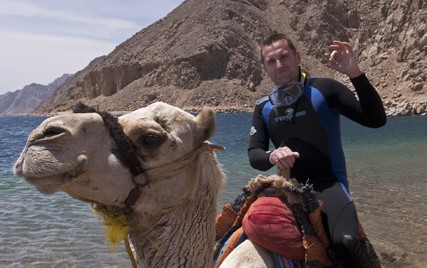 Our camels didn’t turn up until later in the afternoon. Dave had already tooled himself up with a Keffiyeh (head dress) and was eager to get going. Full dive gear including cylinders and weight belts were carefully loaded onto our rides. Mamdouh said that camels can carry loads of up to 300kg. Mounting a camel required some intense concentration. From a sitting down position the camel first came up on its hind legs and then its front legs. Grabbing the saddle horns for balance is a critical part of the ‘staying on’ process. There must have been a good 2 metres clearance from the ground. Mamdouh said wearing jeans and shoes would make the journey more comfortable. Plenty of sunscreen was also a must. Instead of using the stirrups I crossed my legs Bedouin style and held onto the rope attached to the camels head. The rolling motion took a while to get used to. How could these clumsy looking animals be so sure footed? The shoreline was precariously rocky. If I tumbled off there would be some serious damage. Mamdouh even pointed out a pile of camel bones at the base of the cliff we were climbing just to make me feel more at ease. Camels live for around 30 years and cost about 6,000 Egyptian pounds (£600 Sterling) to buy. They can last as long as 2 weeks without water and even taste good to eat. I could now see why camels were such a useful animal. Dave seemed to be having a few problems with steering his camel and ended up going off the track while mine decided to stop for a quick chew on a discarded bamboo stick. We had absolutely no control at all. After 2 hours of plodding along we caught site of our final destination, Ras Abu Gulum. When I dismounted the word ‘rawhide’ took on a whole new meaning. So this is how cowboys must have felt after a hard day in the saddle?
Our camels didn’t turn up until later in the afternoon. Dave had already tooled himself up with a Keffiyeh (head dress) and was eager to get going. Full dive gear including cylinders and weight belts were carefully loaded onto our rides. Mamdouh said that camels can carry loads of up to 300kg. Mounting a camel required some intense concentration. From a sitting down position the camel first came up on its hind legs and then its front legs. Grabbing the saddle horns for balance is a critical part of the ‘staying on’ process. There must have been a good 2 metres clearance from the ground. Mamdouh said wearing jeans and shoes would make the journey more comfortable. Plenty of sunscreen was also a must. Instead of using the stirrups I crossed my legs Bedouin style and held onto the rope attached to the camels head. The rolling motion took a while to get used to. How could these clumsy looking animals be so sure footed? The shoreline was precariously rocky. If I tumbled off there would be some serious damage. Mamdouh even pointed out a pile of camel bones at the base of the cliff we were climbing just to make me feel more at ease. Camels live for around 30 years and cost about 6,000 Egyptian pounds (£600 Sterling) to buy. They can last as long as 2 weeks without water and even taste good to eat. I could now see why camels were such a useful animal. Dave seemed to be having a few problems with steering his camel and ended up going off the track while mine decided to stop for a quick chew on a discarded bamboo stick. We had absolutely no control at all. After 2 hours of plodding along we caught site of our final destination, Ras Abu Gulum. When I dismounted the word ‘rawhide’ took on a whole new meaning. So this is how cowboys must have felt after a hard day in the saddle?
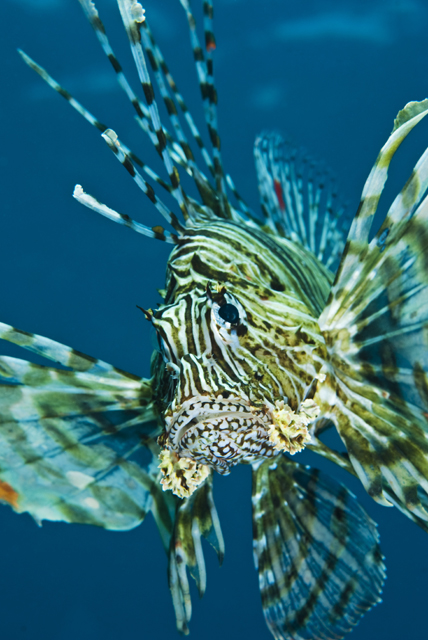 Clear blue sky, rugged mountains and km upon km of deserted coastline; this definitely scored a 10 out of 10 on the scenic ‘wow factor’ and what a total contrast to the blue hole. Mamdouh said that our first dive site would be Daheila. We kitted up and waded straight into the water. I followed Dave and Mamdouh down to 25 metres. The corals were in pristine condition with plenty of fish activity from damsels to predatory jacks. But we were still suffering with poor visibility which, on a photography level, was seriously stressing me out. Macro shots were okay but wide angle was causing me big problems.
Clear blue sky, rugged mountains and km upon km of deserted coastline; this definitely scored a 10 out of 10 on the scenic ‘wow factor’ and what a total contrast to the blue hole. Mamdouh said that our first dive site would be Daheila. We kitted up and waded straight into the water. I followed Dave and Mamdouh down to 25 metres. The corals were in pristine condition with plenty of fish activity from damsels to predatory jacks. But we were still suffering with poor visibility which, on a photography level, was seriously stressing me out. Macro shots were okay but wide angle was causing me big problems.
Our second dive site was located approx 1km north at a place called Al Garden or the rock. Walking over the slippery stones in full kit was a bit tricky, especially when the oncoming waves were knocking us off balance. We ducked down and followed the contours of the sandy slope to a depth of 20 metres. There were giant table corals and clumps of reef bursting with bright orange anthias, anemone fish, groupers and lionfish. Mamdouh’s favourite spot was a coral pinnacle full of juvenile trigger fish. In clear, calm conditions this would have been an awesome shore dive.
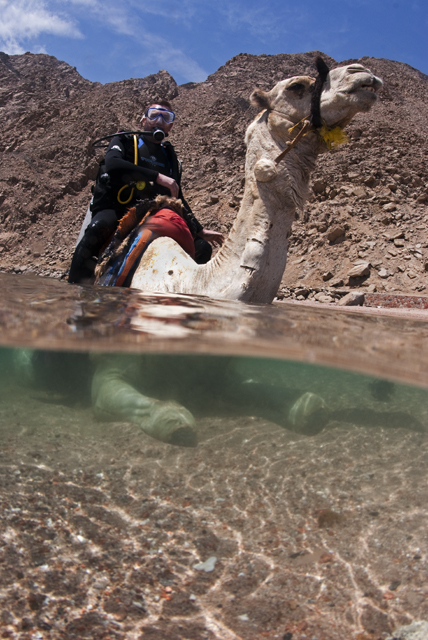 Hayden described our accommodation as ‘rustic’. I guess that was a good word to use. I’m not sure what star rating I would give the place. It was basically a lean-too on the beach. But to be honest this just added to the atmosphere. The natural shallow lagoon was perfect for kite and wind surfing. Hayden said ‘there are no buildings around to cause any wind pollution’. I saw one lone kite surfer having a whale of a time. I wondered how long it would be before mass tourism found the blue lagoon? I sat chilling with Dave drinking a few beers and eating our spicy fish supper. The night sky was alive with so many shooting stars. The only artificial glow of lights was way off in the distance in the direction of Dahab.During the night I dreamt up an interesting idea for a picture. Why not get a camel to sit in the sea with a scuba diver posing in the saddle (well, it seemed like a good idea at the time). Using my wide angle dome port I could even try for a 50/50 above/below water shot. Dave from Dahab was willing to give it a try so we just needed to find a sacrificial camel. After greasing a Bedouin’s palm with a wad of Egyptian pounds we managed to persuade a camel to go into the water. But as I lined up for a picture the camel decided to offload a pile of poo which floated down in my direction. Obviously the shock of the cold water was enough to start off a chain reaction! In the camels defence it was only mid-April and the water temp was still a cool 21 – 22 degrees. I had all of 2 minutes to get my picture before the camel decided enough was enough and got up with Dave still holding on for dear life. We tried to get the camel back in the water but it just wasn’t having it.
Hayden described our accommodation as ‘rustic’. I guess that was a good word to use. I’m not sure what star rating I would give the place. It was basically a lean-too on the beach. But to be honest this just added to the atmosphere. The natural shallow lagoon was perfect for kite and wind surfing. Hayden said ‘there are no buildings around to cause any wind pollution’. I saw one lone kite surfer having a whale of a time. I wondered how long it would be before mass tourism found the blue lagoon? I sat chilling with Dave drinking a few beers and eating our spicy fish supper. The night sky was alive with so many shooting stars. The only artificial glow of lights was way off in the distance in the direction of Dahab.During the night I dreamt up an interesting idea for a picture. Why not get a camel to sit in the sea with a scuba diver posing in the saddle (well, it seemed like a good idea at the time). Using my wide angle dome port I could even try for a 50/50 above/below water shot. Dave from Dahab was willing to give it a try so we just needed to find a sacrificial camel. After greasing a Bedouin’s palm with a wad of Egyptian pounds we managed to persuade a camel to go into the water. But as I lined up for a picture the camel decided to offload a pile of poo which floated down in my direction. Obviously the shock of the cold water was enough to start off a chain reaction! In the camels defence it was only mid-April and the water temp was still a cool 21 – 22 degrees. I had all of 2 minutes to get my picture before the camel decided enough was enough and got up with Dave still holding on for dear life. We tried to get the camel back in the water but it just wasn’t having it.
Our initial plans were for 3 dives a day plus a night dive, but we decided to cut our trip short due to the adverse conditions. Instead of returning to the blue hole on camels we got a lift back in Hayden’s pick-up truck. To be honest I thought the camel ride was far more comfortable. Hayden’s pick-up really did take a heavy beating over the rough terrain. I definitely wouldn’t want to pay his next maintenance bill. I asked Dave what he thought about the safari and he said ‘It was an adventure. It was nothing like staying in a 5 star hotel, but that’s why you try out different things, to make life more interesting’. This was Dave’s first experience on a camel. He said “I was apprehensive at first. They seemed to have a mind of their own”. I asked Dave if he would go again and he said “Next time I would go later in the year when it’s a bit warmer”.
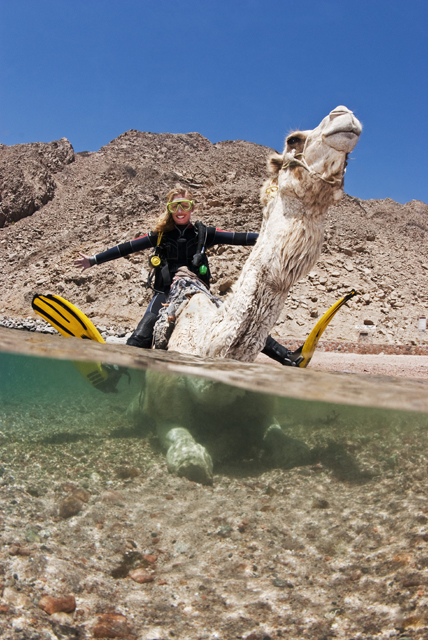 I was still determined to get my camel picture, so a few days later I returned with Hayden and Nic from Black Rock diving to try again. This time we walked all the way from the blue hole to Ras Abu Gulum. Hayden’s breakneck pace was similar to a forced march in the French Foreign Legion. In the sweltering hot midday sun it was more a case of march or die! Hayden had recruited Bedouin rider Telal and his trusty steed Asfall, the coolest of all camels, for the photo shoot. This time I managed to get 4 x 5 minute sessions with Nic astride Asfall and was much happier with the pictures. Now I could understand why no one else had attempted this composition before.
I was still determined to get my camel picture, so a few days later I returned with Hayden and Nic from Black Rock diving to try again. This time we walked all the way from the blue hole to Ras Abu Gulum. Hayden’s breakneck pace was similar to a forced march in the French Foreign Legion. In the sweltering hot midday sun it was more a case of march or die! Hayden had recruited Bedouin rider Telal and his trusty steed Asfall, the coolest of all camels, for the photo shoot. This time I managed to get 4 x 5 minute sessions with Nic astride Asfall and was much happier with the pictures. Now I could understand why no one else had attempted this composition before.
Hayden said he organised camel dive safaris that went still further up the coast to Lagoona and beyond. Normally they lasted 2 days and 2 nights but this can be tailored to suit. I would recommend going slightly later in the season as April can still be quite chilly at night, especially when the wind blows. While Dave and I were shivering away our guide Mamdouh was tucked up snug and toasty inside his sleeping bag- thanks for your concern Mamdouh!
Prices for Black Rock’s camel dive safari are approx 80 euro a day on top of the normal dive price. This includes all transfers, soft drinks, food, accommodation, camels and diving.
Gear News
Go anywhere with Stahlsac
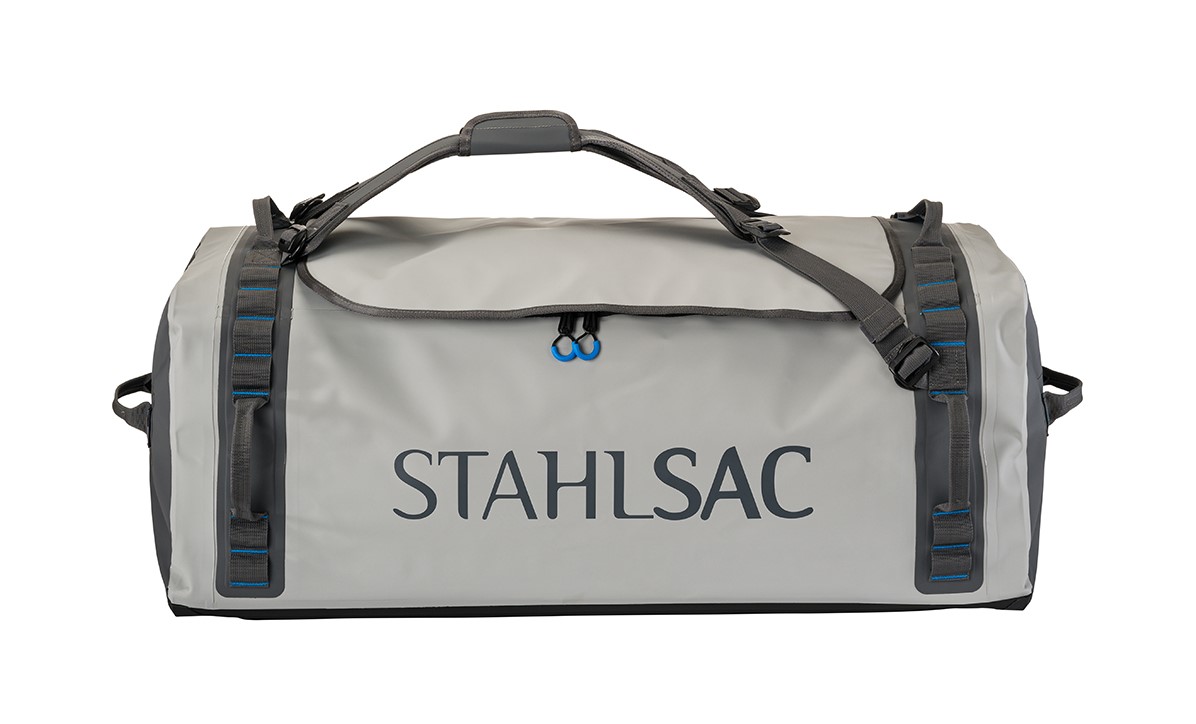
Stahlsac dive bags and travel luggage are built for our community of divers, surfers, kayakers and outdoor explorers who need bags that are constructed with durability, toughness, and 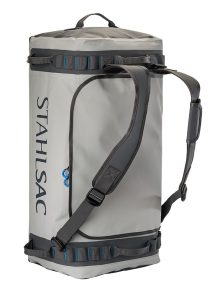 the highest quality the industry has ever seen. We were founded by one man determined to build better watersports and dive bags, and today, that mission is carried on by many. Adventure doesn’t just present itself; it requires discovery. When we design dive bags, we make sure they are tough enough for you to explore in all conditions—warm and cold, wet and dry—to the nearest and farthest reaches of the earth. And for those times you want to push the boundaries of adventure, Stahlsac dive bags make sure you can truly GO ANYWHERE.
the highest quality the industry has ever seen. We were founded by one man determined to build better watersports and dive bags, and today, that mission is carried on by many. Adventure doesn’t just present itself; it requires discovery. When we design dive bags, we make sure they are tough enough for you to explore in all conditions—warm and cold, wet and dry—to the nearest and farthest reaches of the earth. And for those times you want to push the boundaries of adventure, Stahlsac dive bags make sure you can truly GO ANYWHERE.
Abyss Duffels
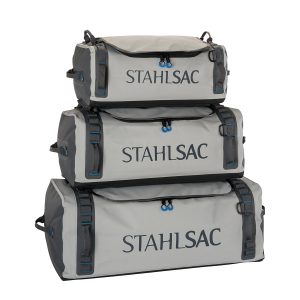 Made to be your partner-in-crime on every adventure, Stahlsac’s Abyss Duffels protects your gear from Mother Nature’s worst. Tough and 100% waterproof with double-TPU nylon material that shrugs off daily wear-and-tear, and RF-welded seams further boost the bag’s potential for lifelong exploring. Get Wet. Get Lost. Go Anywhere with Abyss.
Made to be your partner-in-crime on every adventure, Stahlsac’s Abyss Duffels protects your gear from Mother Nature’s worst. Tough and 100% waterproof with double-TPU nylon material that shrugs off daily wear-and-tear, and RF-welded seams further boost the bag’s potential for lifelong exploring. Get Wet. Get Lost. Go Anywhere with Abyss.
- A weatherproof duffel for trips, travel, and adventure
- Ultra-durable double-TPU nylon protects your gear
- Material repels water and keeps your equipment dry
- RF-welded seams are flush, tough, and waterproof
- Removable straps transform duffel into backpack
- Zippered internal stow compartments carry essentials
- External zippered flap is easy to open and close
- Welded external handles make transporting a breeze
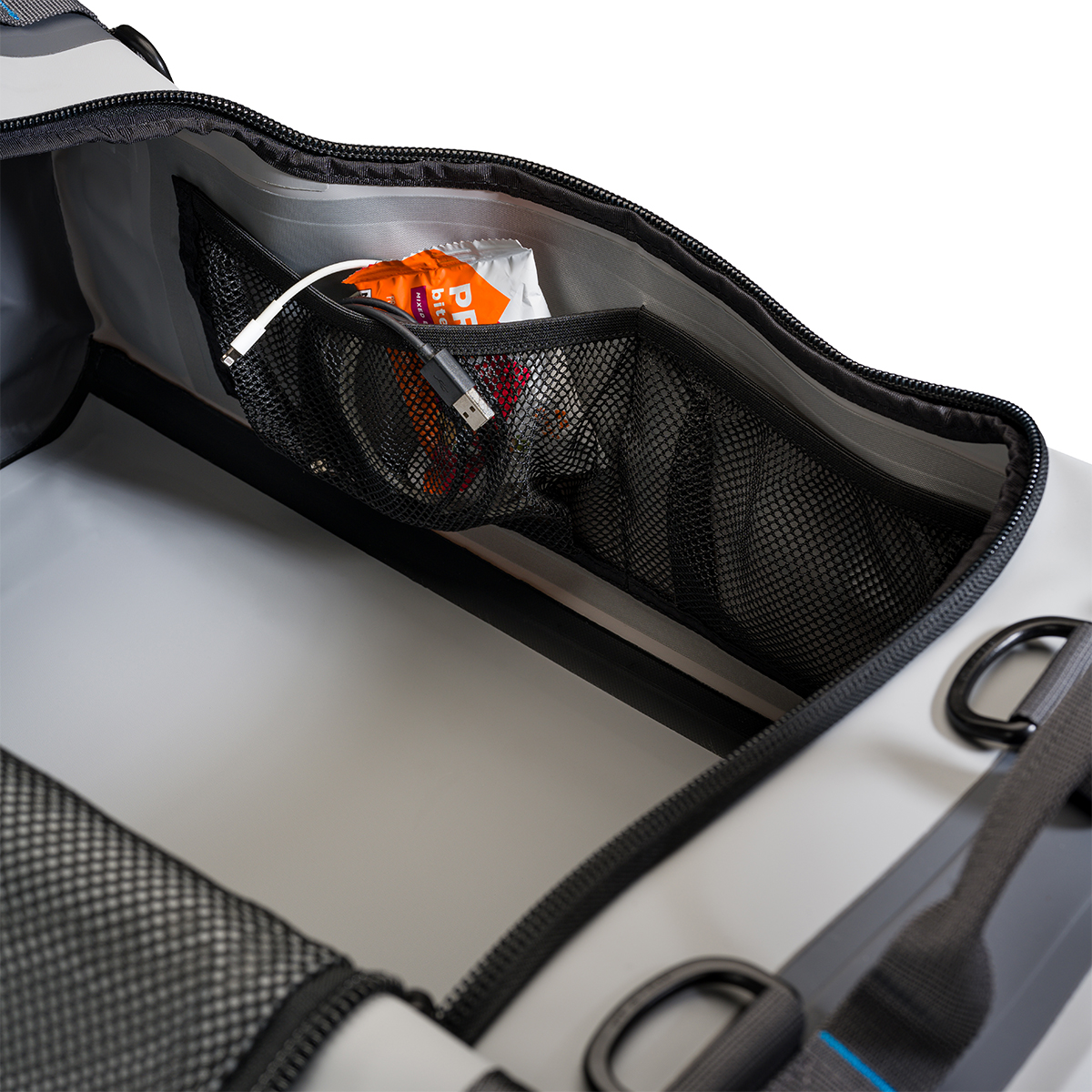
Panama Mesh Backpack
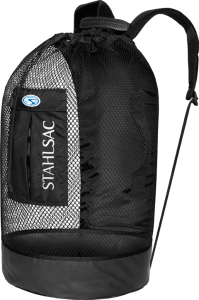 The most copied design in scuba diving, the Stahlsac Panama Mesh Backpack is the “original” design and features two high-density foam padded shoulder straps, extra durable polyester mesh, duffel bag handles and our unique zippered dry pocket inside that combines with a wet pocket outside. The bottom’s built from reinforced 18-gauge PVC nylon to combat the wear and tear of your active coastal lifestyle, and, as a bonus in every bag, we supply a 12″ x 12″ mesh drawstring satchel for extra stowing utility. Pack up your beach kit and go.
The most copied design in scuba diving, the Stahlsac Panama Mesh Backpack is the “original” design and features two high-density foam padded shoulder straps, extra durable polyester mesh, duffel bag handles and our unique zippered dry pocket inside that combines with a wet pocket outside. The bottom’s built from reinforced 18-gauge PVC nylon to combat the wear and tear of your active coastal lifestyle, and, as a bonus in every bag, we supply a 12″ x 12″ mesh drawstring satchel for extra stowing utility. Pack up your beach kit and go.
- Density foam padded shoulder straps
- Outside wet/dry pockets
- 2 Carry handles
- Tough, snag-resistant polyester mesh
- Reinforced PVC bottom
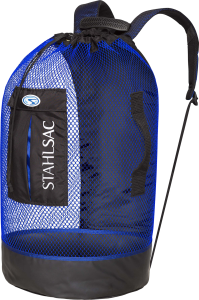
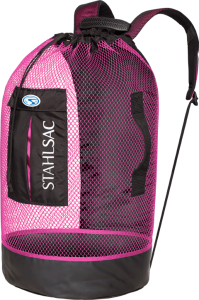
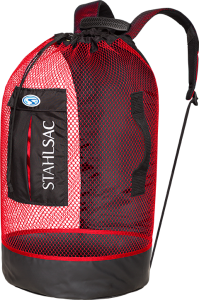
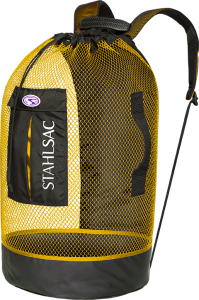
For more information about Stahlsac bags, visit www.stahlsac.com/dive-bags.
Sea & Sea is the home of Stahlsac and other leading diving brands in the UK.
Blogs
EXCLUSIVE: Jeff Goodman interviews Mark Spiers, CEO of New Scuba Diving Training Agency NovoScuba

In a video recorded exclusively for Scubaverse.com, Jeff Goodman interviews Mark Spiers, CEO of new scuba diving training agency NovoScuba.
Find out more about NovoScuba at www.novoscuba.com.
-

 News3 months ago
News3 months agoCapturing Critters in Lembeh Underwater Photography Workshop 2024: Event Roundup
-

 Marine Life & Conservation Blogs3 months ago
Marine Life & Conservation Blogs3 months agoCreature Feature: Swell Sharks
-

 Blogs2 months ago
Blogs2 months agoMurex Resorts: Passport to Paradise!
-

 Blogs2 months ago
Blogs2 months agoDiver Discovering Whale Skeletons Beneath Ice Judged World’s Best Underwater Photograph
-

 Gear Reviews3 weeks ago
Gear Reviews3 weeks agoGEAR REVIEW – Revolutionising Diving Comfort: The Sharkskin T2 Chillproof Suit
-

 Gear Reviews3 months ago
Gear Reviews3 months agoGear Review: Oceanic+ Dive Housing for iPhone
-

 News2 months ago
News2 months agoPADI Teams Up with Wellness Brand Neuro to Drive Ocean Change and Create a Blue State of Mind
-

 Marine Life & Conservation2 months ago
Marine Life & Conservation2 months agoSave the Manatee Club launches brand new webcams at Silver Springs State Park, Florida


